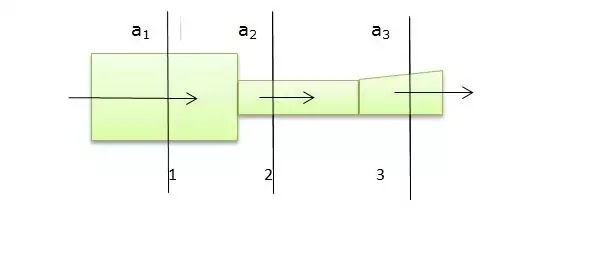FLUID KINEMATICS
Definition: -It is the branch of fluid mechanics which deals with the study of velocity and acceleration of the fluid particles without reference to the force causing the motion.
The fluid motion can be describe by two methods-
- Lagrangian Method:In this process each particle is observed throughout the flow and at different points, fluid properties are measured. This method is generally not used.
- Eulerian Method: In control volume analyses, it is convenient to use the Eulerian method of description, which focuses on the properties of a flow at a given point in space as a function of time.
Description of Flow pattern:
The flow pattern of any fluid flow system may be described by means of streamlines, path lines, streak line and time lines.
Stream line – It is an imaginary line drawn in the flow field such that the tangent drawn at any point on this line represents the direction of velocity vector of the fluid particles at that point.
Streak line – It is an imaginary line which is passing through the points which have passed through a same point after a given time interval.
Path line – It is a line or the locus of the fluid particle in a fluid field.
[NOTE: For steady flow, Stream line, Path line and streak line co-insides each other.]
Types of Fluid flow:
Steady flow and Unsteady flow: -
If velocity of fluid and other fluid properties does not change with respect to time at a point, then this type of flow is called steady flow.
(𝛿v/𝛿t)|space= 0 (𝛿p/𝛿t)|space= 0 (𝛿ρ / 𝛿t)|space= 0
If velocity of fluid and other fluid properties changes with respect to time at a point, then this type of flow is called unsteady flow.
(𝛿v/𝛿t)|space ≠ 0 (𝛿p/𝛿t)|space≠ 0 (𝛿ρ / 𝛿t)|space ≠ 0
Uniform flow and Non-uniform flow: -
If velocity of fluid and other fluid properties at any given time does not change with respect to space (i.e. same in all point), then this type of flow is called uniform flow.
(𝛿v/𝛿space)|time= 0 (𝛿p/𝛿space)|time= 0 (𝛿ρ / 𝛿space)|time= 0
If velocity of fluid and other fluid properties at any given time changes with respect to space (i.e. same in all point), then this type of flow is called non-uniform flow.
(𝛿v/𝛿space)|time ≠ 0 (𝛿p/𝛿space)|time ≠ 0 (𝛿ρ /𝛿space)|time ≠ 0
*Some examples of flow: -
| Constant flow in a pipe of constant cross section area | Steady & Uniform flow |
| Increasing or decreasing flow in a pipe of constant cross section area | Unsteady & Uniform flow |
| Constant flow in a pipe of non-uniform cross section area | Steady & non-uniform flow |
| Increasing or decreasing flow in a pipe of non-uniform cross section area | Unsteady & non-uniform flow |
Laminar flow and turbulent flow: -
If the particles of fluid move along a streamline i.e. along layers and do not cross each other, then the flow is called Laminar flow.
Streamline is defined as a line of equal velocity of fluid particle in flow.
In turbulent flow, particles of fluid attain such a velocity that velocity of each particle varies point to point in magnitude and direction as well, from instant to instant
Whether a flow is laminar or turbulent, it is defined by Reynolds no. (Re)
| Type of Flow | Reynolds no. for closed channel | Reynolds no. for open channel |
| Laminar | Re <2000 | Re<500 |
| Transition | 2000 ≤ Re ≥ 4000 | 500 ≤ Re ≥ 2000 |
| Turbulent | Re>4000 | Re>2000 |
Rotational flow and Irrotational flow: -
If fluid particles rotate about their own axis, while moving in the direction of flow, is called rotational flow, otherwise irrotational flow.
Compressible flow and Incompressible flow: -
If the density of fluid changes point to point when flowing is called compressible flow.
If the density of fluid does not change point to point when flowing is called incompressible flow i.e. ρ = constant.
One, Two and Three dimensional flow: -
In one dimensional flow, the fluid parameters remain constant throughout any cross-section normal to flow direction but vary along longitudinal direction. [u =f(x), v=0, w=0]
In two dimensional flow, the fluid parameters can vary along two direction. [u =f1(x,y), v= f2(x,y), w=0]
In three dimensional flow, fluid parameters can vary in all three direction. [u =f1(x,y,z), v= f2(x,y,z), w= f3(x,y,z),]
Acceleration of Fluid particles: -
a= u(𝛿V/ 𝛿x) +v (𝛿V/ 𝛿y) + w (𝛿V/ 𝛿z) + (𝛿V/𝛿t)
Acceleration in ‘X’ direction –
ax= u (𝛿u/ 𝛿x) +v (𝛿u/𝛿y) + w (𝛿u/𝛿z) + (𝛿u/𝛿t)
Acceleration in ‘Y’ direction -
ay= u (𝛿v/ 𝛿x) +v (𝛿v/𝛿y) + w (𝛿v/𝛿z) + (𝛿v/𝛿t)
Acceleration in ‘Z’ direction -
az= u (𝛿w/ 𝛿x) +v (𝛿w/𝛿y) + w (𝛿w/𝛿z) + (𝛿v/𝛿t)
a = √ (ax2 + ay2 + az2)
General form of Continuity Equation: -
(𝛿ρ / 𝛿t) + (𝛿ρu /𝛿x) + (𝛿ρv /𝛿y) + (𝛿ρw /𝛿z) =0
For steady flow – (𝛿ρ /𝛿t) =0
(𝛿ρu / 𝛿x) + (𝛿ρv /𝛿y) + (𝛿ρw /𝛿z) =0
For steady and compressible flow – ρ =cost.
(𝛿u / 𝛿x) + (𝛿v /𝛿y) + (𝛿w /𝛿z) =0 [For three dimensional flow]
(𝛿u / 𝛿x) + (𝛿v /𝛿y) =0 [For two dimensional flow]
Equation of Continuity: -If an incompressible liquid is continuously flowing through a pipe or a channel, the quantity of liquid passing per second is the same at all section.
This is based on the principle of Conversion of mass.
For one dimensional incompressible flow,
a1v1= a2v2 = a3v3
Q1 = Q2 = Q3
 |
| Fig. 1 | Equation of Continuity |
If flow is compressible, then ρ1a1v1 = ρ2a2v2= ρ3a3v3





0 Comments
Please do not enter any spam link in the comment box